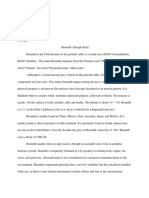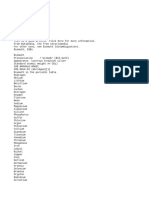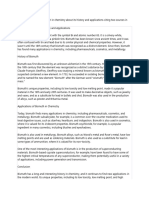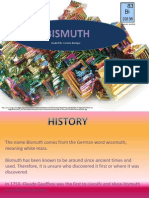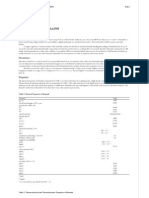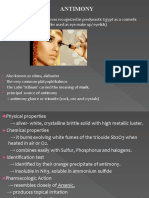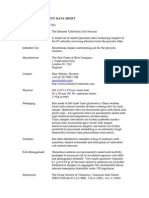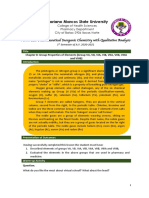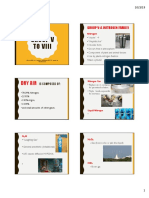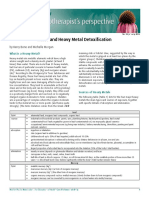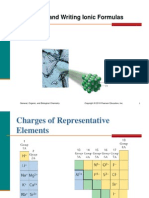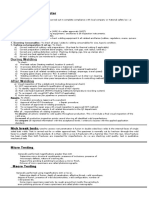A method is described for the rapid accurate determination of small quantities of bismuth in body fluids and tissues.
This depends upon the wet combustion of the organic matter, followed by colorimetric determination Home > Periodic table > Elements > Bismuth
Bismuth - Bi
Chemical properties of bismuth - Health effects of bismuth Environmental effects of Bismuth
Atomic number Atomic mass Electronegativity according to Pauling Density Melting point Boiling point Vanderwaals radius Ionic radius Isotopes Electronic shell Energy of first ionisation Energy of second ionisation Energy of third ionisation Energy of fourth ionisation Energy of fifth ionisation Standard potential Discovered by 83 208.9804 g.mol -1 1.9 9.80 g.cm-3 at 20C 271 C 1420 C 0.152 nm 0.074 nm (+5) ; 0,120 nm (+3) 14 [ Xe ] 4f14 5d10 6s2 6p3 703 kJ.mol -1 1610 kJ.mol -1 2466 kJ.mol -1 4362,3 kJ.mol -1 5394 kJ.mol -1 0.32 V ( Bi3+/ Bi ) The ancients
Bismuth
Bismuth is a white, crystalline, brittle metal with a pinkish tinge. Bismuth is the most diamagnetic of all metals, and the thermal conductivity is lower than any metal except mercury. It has a high electrical resistance, and has the highest Hall effect of any metal (that is, the greatest increase in electrical resistance when placed in a magnetic field). Bismuth is stable to oxygen and water but dissolves in concentrated nitric air. All bismuth salts form insoluble compounds when put into water. Applications Bismuth metal is used in the manufacture of low melting solders and fusible alloys as well as low toxicity bird shot and fishing sinkers. Certain bismuth compounds are also manufactured and used as pharmaceuticals. Industry makes use of bismuth compounds as catalysts in manifacturing acrylonitrile, the starting material for synthetic fibers and rubbers. Bismuth is sometimes used in the production of shot and shotguns. Bismuth in the environment
�The most important ores of bismuth are bismuthimite and bismite. Bismuth occurs naturally as the metal itself and is found as crystals in the sulphides ores of nickel, cobalt, silver and tin. Bismuth is mainly produced as a byproduct from lead and copper smelting, especially in USA. The chief areas where it is mined are Bolivia, Peru', Japan, Mexico and Canada, but only to the extent of 3.000 tonnes per year. There is no reliable estimate of how much bismuth is available to be mined, but it seems unlikely than there will ever be a shortage of this metal.
Health effects of bismuth
Bismuth and its salts can cause kidney damage, although the degree of such damage is usually mild. Large doses can be fatal. Industrially it is considered one of the less toxic of the heavy metals. Serious and sometimes fatal poisoning may occur from the injection of large doses into closed cavities and from extensive application to burns (in form of soluble bismuth compounds). It is stated that the administration of bismuth should be stopped when gingivitis appears, for otherwise serious ulceration stomatitis is likely to result. Other toxic results may develop, such as vague feeling of bodily discomfort, presence of albumin or other protein substance in the urine, diarrhea, skin reactions and sometimes serious exodermatitis. Routes of entry: Inhalation, skin and ingestion. Acute effects: Inhalation: POISON. May be a nuisance dust causing respiratory irritation. May cause foul breath, metallic taste and gingivitis. Ingestion: POISON. May cause nausea, loss of appetite and weight, malaise, albuminuria, diarrhea, skin reactions, stomatitis, headache, fever, sleeplessness, depression, rheumatic pain and a black line may form on gums in the mouth due to deposition of bismuth sulphide. Skin: May cause irritation. Eyes: May cause irritation. Chronic effects: Inhalation: May affect the function of the liver and the kidneys. Ingestion: May affect the function of the liver and the kidneys. May cause anemia, black line may form on gums and ulcerative stomatitis. Skin: May cause dermatitis. Eyes: No chronic health effects recorded. Medical conditions generally aggravated by the exposure: Pre-existing skin and respiratory disorders. Bismuth is not considered a human carcinogen.
Environmental effects of Bismuth
Bismuth metal is not considered toxic and poses minimum threat to the environment. Bismuth compounds generally have very low solubility but they should be handled with care, as there is only limited information on their effects and fate in the environment.
Back to chart periodic elements.
About Lenntech Turnkey plants Pilot plants Containerized plants Services Career at Lenntech International Internships Periodic table Calculators Visitors information Our partners Contact us
�Lenntech BV
Rotterdamseweg 402 M 2629 HH Delft The Netherlands tel: +31 15 261 09 00 fax: +31 15 261 62 89 e-mail: info@lenntech.com
Elements
Actinium Silver Aluminum Americium Argon Arsenic Astatine Gold Boron Barium Beryllium Bohrium Bismuth Berkelium Bromine Carbon Calcium Cadmium Cerium Californium Chlorine Curium Cobalt Chromium Cesium Copper Dubnium Darmstadtium Dysprosium Erbium Einsteinium Europium Fluorine Iron Fermium Francium Gallium
Gadolinium Germanium Hydrogen Helium Hafnium Mercury Holmium Hassium Iodine Indium Iridium Potassium Krypton Lanthanum Lithium Lawrencium Lutetium Mendelevium Magnesium Manganese Molybdenum Meitnerium Nitrogen Sodium Niobium Neodymium Neon Nickel Nobelium Neptunium Oxygen Osmium Phosphorus Protactinium Lead Palladium Promethium Polonium Praseodymium Platinum Plutonium Radium Rubidium Rhenium Rutherfordium Roentgenium Rhodium Radon Ruthenium Sulfur Antimony Scandium Selenium Seaborgium Silicon Samarium Tin Strontium Tantalum Terbium Technetium Tellurium Thorium
bool
Search
>>
Request a quote ?
Home Applications Process water Drinking water Irrigation water Ultra pure water Emergency water supply Processes Sea water desalination Surface water treatment Water softening systems Disinfection Remineralisation Waste water treatment Pesticide treatment Iron and manganese Arsenic removal Heavy metal removal Nitrates treatment Systems
o o o o o o o o o o o o o o o o o o o o o o o o
Field Code Changed
Field Code Changed
Field Code Changed
Deep filtration Reverse osmosis Ultrafiltration Ion exchange Ozone disinfection
UV disinfection ClO2 disinfection Sediment filters Clarifiers Products
o o o o o o o o o o o o
Field Code Changed
Sediment filters Filtration media RO membrane Ion exchange resins Chemicals Measurement devices Hayward Cartridge filters
Field Code Changed
Library
o o o o o o o o o o o o o o o o o o o o o o o o
Reverse osmosis Ion exchange Electrodionisation Ultrafiltration Media filtration Coagulation - floculation Clarification Fine filtration Particles size Beta Ratio Bubble point Absolute Vs. nominal rating for filters Oil filtration and Oil-Block filters Zeta potential UV Chlorine dioxide Ozone Regeneration active carbon Adsorption Advanced oxidation Hydrogen peroxide Catalytic Wet Air Oxidation (CWAO) Sludge treatment o Waterborne diseases Languages
o o o o o o o o o o
Deutsch English Espaol Franais Italiano Nederlands Polski Portugus
Field Code Changed
Copyright 1998-2011 Lenntech B.V | Email: info@lenntech.com | Tel. +31 15 261 09 00 | Fax. +31-15-2616289
Read more: http://www.lenntech.com/periodic/elements/bi.htm#ixzz1mkkYcZ7c
of bismuth as the iodide.



